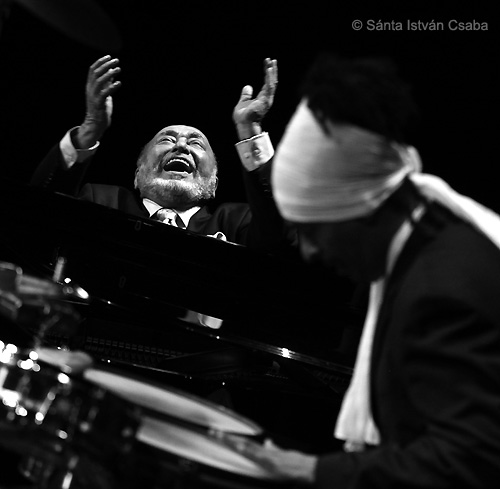Eddie Palmieri is a new NEA Jazz Master — to be inducted Jan. 14 in a ceremony at Dizzy’s Club in Jazz at Lincoln Center, to be webcast live. He is, contradictorily, the spark-plug/conservator of the Americas’ indefatigable Afro-Caribbean music. He turned 76 yesterday (Dec. 15), celebrating with a a “career retrospective” featuring his jazz band and dance ensemble at JALC’s Hall. Here’s Palmieri’s portrait with his timbalero José Claussell, taken last night by Sánta István Csaba, a Budapest-based photographer currently visiting New York City.

Eddie Palmieri and José Claussell at Jazz at Lincoln Center, Dec. 15 2012, photo by Sánta István Csaba
Palmieri has been a leader in America’s “Latin” music since the early ’60s — a composing and arranging pianist, a dramatic improviser, a hard-touring and often recording artist, a progressive political voice — but one who consciously harkens back at least a decade earlier, to the musical era from which he sprung. For his concert’s first Rose Hall set on Friday, 12/13  Palmieri opened with an impromptu and intimately moody (if hastily resolved) piano solo, then brought his congos-bongos-timbales-bass clavé section and alto sax, trumpet, trombone horn line (plus upright bass) together for the title track of his slinky, intricate 2005 album Palmas. He introduced a composition dedicated to Thelonious Monk incorporating unusual-for-Latin off-kilter hesitations; he played startling dissonant chords and unexpected chromatic modulations under section writing that required full engagement and vigor from trumpeter Brian Lynch, trombonist Conrad Herwig, saxist Louis Fouché; he drew energy from his drummers. This was some jazz hot.
For his second set, Palmieri added vocalist Herman Olivera, trés virtuoso Nelson Gonzalez (and his son as a backup singer/rhythmist),  exciting ‘boneman Jimmy Bosch — to delve into the 1950s’ rhumba-mambo-cha-cha stylings of Tito Rodriguez, Machito and Tito Puente. This orchestral popular dance music may have become formalized in the past 50+ years, but remains as multi-layered and compelling as ever, if played well. Palmieri and Co. played it well, though this repertoire left a bulk of Palmieri’s career unasserted. His charanga innovations and collaborations with Cal Tjader, boogaloo funk, dynamic electric (pre-Santana) jams, grandiose self-referential works, and ethnomusicological interpretations were missing. Yes, he’s a Jazz Master — but what’s he thinking up now?
I’ve written about Palmieri several times on this blog, including this an enthusiastic review of his 2009 JALC debut with his  neo-charanga ensemble La Perfecta II.
Here’s my posting when Palmieri’s Jazz Masters Award was announced — plus notes on the rest of the distinguished class —
And here’s the post from last year with my nomination of him for the NEA Jazz Master honor. Which begs the question — Who next?
See my nomination tomorrow.
